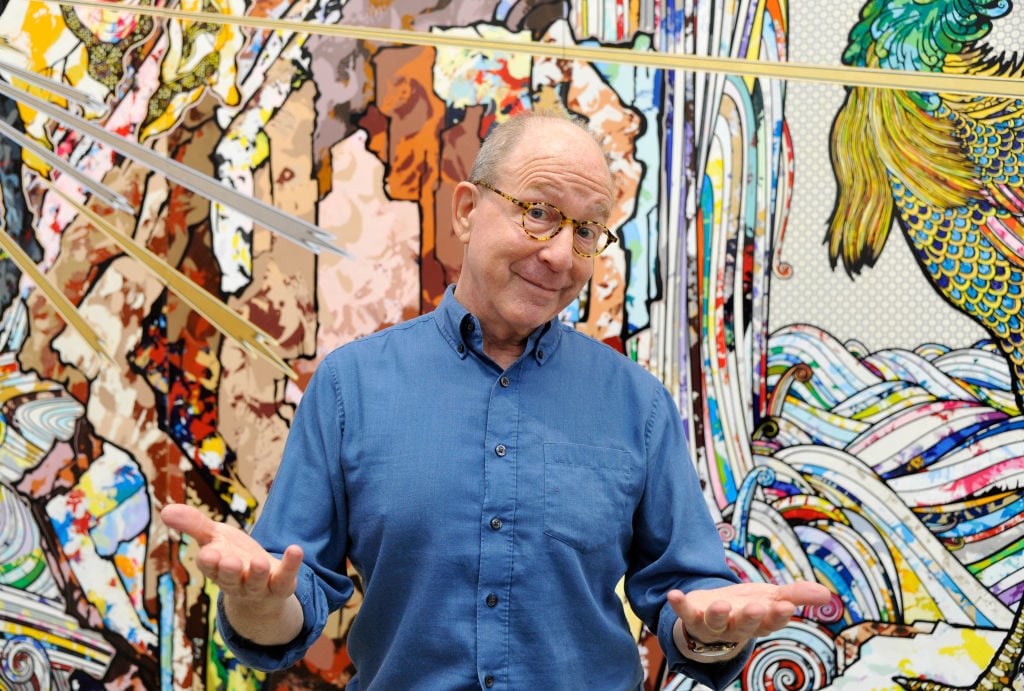Art World Archives
Art Critic Jerry Saltz Gets Into an Online Skirmish With A.I. Superstar Refik Anadol
Saltz enraged Anadol after dismissing his latest installation at MoMA.

Saltz enraged Anadol after dismissing his latest installation at MoMA.

Jo Lawson-Tancred

Does comparing a piece of digital art to a screensaver count as a diss? An online skirmish between famous A.I. artist Refik Anadol and New York Magazine’s senior art critic Jerry Saltz escalated into full-on beef on X over Thanksgiving weekend. It raised age-old questions about the role of art critics, but this time the whole Web3 community got involved.
The fight broke out over Unsupervised, a 24-foot-tall screen-based work installed on the ground floor of the Museum of Modern Art in New York in 2022 and recently acquired for the museum’s permanent collection. Undeniably eye-catching, it is made up of multi-dimensional waves of color that represent an algorithm’s interpretation of MoMA’s entire online catalog, echoing the forms of some of modernism’s most famous movements. Artnet News’s own critic Ben Davis found the work pleasant enough but clearly over-hyped, with MoMA boldly claiming that it “reimagined the history of modern art and dreams about what might have been.”
As is often the way of art critics, Saltz has never minced his words when it comes to appraising the cultural value of Anadol’s work. His review for Vulture in February conceded that Unsupervised was clearly a hit with audiences and, even, “mildly entertaining for whole minutes at a time,” but ultimately found it cosily banal and, if anything, too easy on the eye. “In this hypercontrolled, antiseptic setting, art and doubt maintain separate bedrooms,” he said.
Most memorably, Saltz described the work as “a massive techno lava lamp,” and “a half-million-dollar screensaver.” It is these contentious comparisons that are still being debated on X to this day.
REFIK VS. JERRY pic.twitter.com/RGpVLEXaii
— beeple (@beeple) November 16, 2023
Things kicked off earlier this month, when Saltz synopsized his take on X: “Refik Anadol’s mind-numbing multi-million dollar spectacle is a house of cards and hall of mirrors. Momentary diverting gimmick art. Take away the music and it’s just a banal screensaver.”
Anadol clapped back, saying “ChatGPT writes better than you.” He clarified that he meant anyone “like Jerry” who “needs to research, understand the medium!” His implication seemed to be that Saltz had failed to grasp the work’s technical complexity. Shortly afterwards, Beeple posted an image of Saltz and Anadol in a face-off and Anadol thanked him for “making it more historic.”
The digital art mega-collector Pablo Rodriguez-Fraile, who owns works by Anadol, also weighed in. “The complexity and depth of his installations go far beyond visual aesthetics; they provoke thought, evoke emotion, and invite viewers to engage with art in a fundamentally new way,” he argued. “The widespread connection people feel with his work clearly shows its relevance and impact.”
Whether you could even diss digital art by likening it to a “screensaver” became a matter of widespread debate. Artist Zach Lieberman commented that “screensavers are wild and showed all kinds of other possibilities with computation,” citing pipes, flying toasters, and lissajous figures. Magda Sawon, who co-founded Postmasters Gallery in 1984, said its “Can You Digit?” exhibition from 1996 had a section on screensavers. “Some were top grade art,” she said. “25 freaking years ago.”
A few days later, Saltz re-emphasized, for anyone who was still unclear, that he does not like Anadol’s art. “I have said exactly why,” he said. “I love A.I. art. I love all tools & technologies! I am merely criticizing an artist’s work for what does with their material & tools.”
This is me. Much better than @refikanadol pic.twitter.com/FoQfaA8I5V
By @cemhah— Jerry Saltz (@jerrysaltz) November 24, 2023
“Your words has no meaning to me,” Anadol replied, appearing to be very worked up. “You never talked to me, never visited my studio, no idea who i am, why and how I create art. But Let me tell you; I create my work from my heart!”
“The world you coming from is changed! New world is bright, new world is inclusive, new world has no gates!” he added, concluding: “I’m everyone! You are no one!”
Various anonymous avatars with high follower counts leapt to his defense. The DJ and NFT enthusiast 3LAU wrote: “Good ‘critics’ are last century, funny that is your pride in your bio. No one remembers a critic when they die, people will remember Refik Anadol.”
Saltz has reasserted his right to criticize Anadol’s work, even without a degree in data science. “My job is to look, keep looking,” he said. “My job is to notice things & then say what I noticed. That’s it. We don’t have to agree. I want all artists to be successful. The good, the bad, and the very bad.”
The heated discourse seemed to amplify tensions between the traditional art world’s old guard and the Web3 community, with its strongly held suspicions of “gatekeepers.” The vindictive tone of some of Anadol’s supporters also recalled the backlash experienced by Artnet News’s Davis, who wrote last month about falling foul of “parasocial aesthetics” after he reviewed an exhibition by the TikTok-famous artist Devon Rodriguez. The social media star in turn goaded his furious mob of fans into targeting Davis with an onslaught of insults and threats.
Is there hope that these differences might be put aside? Though the public dispute did not look like it was about to be resolved any time soon, Anadol has since claimed that he and Saltz “are now in an beautiful dialogue.” “This is how we grow, all together,” he concluded, channeling some characteristically Web3 optimism. “Future is bright!”
More Trending Stories:
How an Exclusive NYC Cult Influenced the 1970’s Art Scene
A Rare Soulages Lithograph Possibly Worth $30,000 Sells For $130 in Facebook Marketplace Mishap
Masterpiece or Hot Mess? Here Are 7 Bad Paintings by Famous Artists
Is There a Hat Better Than Napoleon’s? We Rank Art History’s 5 Most Iconic Chapeaux